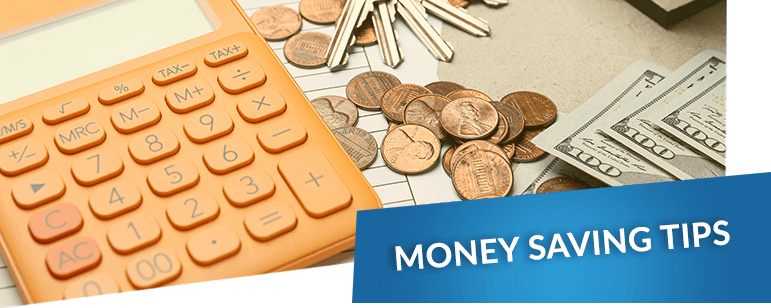As the only part of your car that touches the road, your tyres have a critical role to play in keeping you safe.
Certain changes in your vehicle’s behaviour – like vibrations or noises while driving – can signal that your tyres are wearing unevenly.
Knowing the warning signs to look out for can help you combat uneven tyre wear.
Page Contents
What Causes Uneven Tyre Wear?
Your tyres could be wearing unevenly for any of the following reasons:
- Under-inflated tyres
- Over-inflated tyres
- Incorrect wheel alignment
- Faulty or worn suspension components
- Faulty braking system
Under- and Over-inflated Tyres
If your tyres are over or under-inflated, this can cause increased abrasion between the road and the tyre tread.
Over-inflated tyres are more likely to wear in the centre, whilst under-inflated tyres will wear on the outer section of the tyre.
Both over-inflated and under-inflated tyres pose safety risks for you and your vehicle.
Over-inflation can shorten the lifespan of your tyres and lead to poor handling, reduced vehicle stability and low suspension.
Under-inflated tyres, meanwhile, will experience further rolling resistance, increased fuel consumption and impacted braking performance.
Checking your tyre pressure regularly can help you maximise your safety on the road.
Incorrect Wheel Alignment
Incorrect wheel alignment can lead to uneven tyre wear as misaligned wheels put uneven pressure on the road surface.
When your wheels are incorrectly aligned, this can cause your car to pull to one side, reduced vehicle performance and instability.
Your driving style can also have an impact, as driving into the kerb or over a pothole can knock your wheels out of alignment.
Proper wheel alignment can help you enjoy a smoother ride and save you from accelerated tyre wear and decreased fuel efficiency - so make sure to book your car in for wheel alignment when needed.
It's also important that you have your wheels balanced at the appropriate intervals, so that you can enjoy better handling and extend the lifespan of your tyres.
Faulty Suspension Components
Your car’s suspension ensures a smooth ride when everything is working as expected.
As the suspension absorbs shocks and ensures optimal contact between the tyres and the road’s surface, a suspension problem can lead to uneven tyre wear.
There could be an issue with your car’s suspension - such as worn shock absorbers - if you’ve noticed cupped or scalloped patterns on your tyres, wear on the inner or outer edges of the tyres, or feathering.
Faulty Braking System
If a component has seized in the braking system, or there’s excessive drag, this can cause excessive tyre wear.
When your brakes are faulty, this can put more pressure on one wheel than the others, leading to faster tyre wear.
Signs of Excessive or Uneven Tyre Wear
Your tyres may be wearing unevenly or excessively if you’ve noticed:
- The car pulling to one side
- Visible tyre wear
- Vibration through the steering wheel
- A sawtooth appearance on tyre edges
- Faster tyre wear on the outer edges
- Excessive tyre wear on one side
- Dips or cups in tyre tread
What Does Uneven Tyre Wear Look Like?
Tyre Wear on Both Edges
When your tyres wear excessively on the edges, this can cause the tyre tread to look rounded – a sign that the tyres could be under-inflated.
If your tyres aren’t inflated enough, this can mean that the load in the contact patch on the road surface is uneven.
The central section of the contact patch will not be correctly supported, thereby transferring more load to the outside edges of the tyre.
Tyre Wear in the Middle
Your tyres could be over-inflated if there is excessive wear in the middle section of the tyre.
The tread at the centre of the tyre will support most of the load in this case, meaning this section will wear out faster than the tread at the outer edges.
Tyre Wear on the Outside or Inside (One Edge Only) or Tyre Wear Patterns
If there is excessive wear on only one side of the tyre or patchy patterns of wear, then there could be a suspension problem, such as worn-out bushes or dampers.
Incorrect wheel alignment or camber geometry could also be to blame.
How to Prevent Uneven Tyre Wear
To take good care of your tyres, it is important that you try to avoid potholes and bumping into kerbs when you can.
You should also take care when it comes to hard braking, as this can cause your wheels to lock when travelling at high speeds – causing excessive wear and flat spots on the tyres.
Checking the pressure and tread of your tyres regularly – including your spare tyre – is essential, too.
When the time comes to book a replacement, it is generally recommended that you have the front and rear tyres replaced together.
This is because replacing just one tyre without replacing the tyre on the opposite side of the axle can lead to wheel misalignment and excessive tyre wear.
You can buy tyres and have them fitted by booking with a professional garage.
Finally, of course, you should book a car service regularly to help you avoid abnormal tyre wear.








No comments yet
Leave a comment